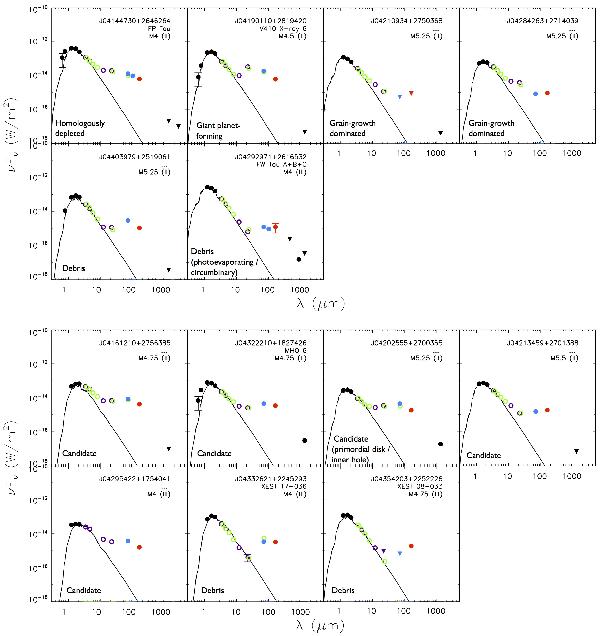Fig. 14

SEDs showing the targets with transition disks (TD) previously reported in the literature (top panel) and the new candidate targets with TDs identified in this paper (bottom panel). Additionally, J04202555+2700355 for which the evolutionary status was previously reported as inconclusive (Currie & Sicilia-Aguilar 2011), is identified as a candidate TD here. For those targets identified in the literature the TD types, compiled from Currie & Sicilia-Aguilar (2011) and Cieza et al. (2012), are displayed on each SED. The candidate TDs are identified by the rising spectral index from 24–70 μm (α24−70 μm> 0). In addition to the positive α24−70 μm indices for XEST 17-036 and XEST 08-033, the α3.6−8.0 μm indices are typical for those of Class III (debris disk) objects. The target name, spectral type, and spectral class are labeled in each SED. The observed broadband photometry (see also Appendix 8) is compiled from optical (RC, IC), and near-IR (2MASS; JHKS) wavelengths (black points), the mid-IR (IRAC and WISE; green and purple open circles respectively), the far-IR (MIPS, PACS blue and red channels; green open circles, blue and red points respectively) and submm-mm wavelengths (black points). 3σ upper limits are represented by the downwards triangles. The best-fit atmospheric model are displayed for each target.
Current usage metrics show cumulative count of Article Views (full-text article views including HTML views, PDF and ePub downloads, according to the available data) and Abstracts Views on Vision4Press platform.
Data correspond to usage on the plateform after 2015. The current usage metrics is available 48-96 hours after online publication and is updated daily on week days.
Initial download of the metrics may take a while.


